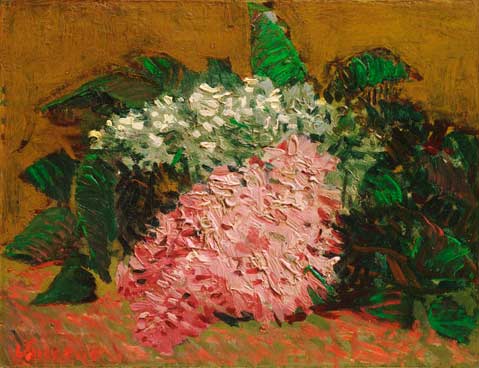Van Gogh to Munch: European Masterworks at the SBMA
Hammer and Blaffer Collections Contribute to This Outstanding Exhibit

For Van Gogh to Munch, Santa Barbara Museum of Art curator Eik Kahng has taken advantage of the availability of masterworks from two outstanding external collections—those of Armand Hammer and Sarah Campbell Blaffer—to invigorate the museuem’s already substantial holdings in 19th- and early-20th-century European painting. Patterns of subject, treatment, gesture, and genre are coordinated in the sequencing and grouping of the works, yielding an aesthetic experience of rich complexity. Comprehending a broad range of styles, this visual journey begins and ends with works from a single crucial moment in the career of Vincent van Gogh.
Van Gogh’s “The Outskirts of Paris” (1886) heralds the painter’s arrival in “the capital of the 19th century.” Although the dark brown and gray palette harkens back to earlier Van Gogh in its modish mix of rural and urban motifs, “Outskirts” reflects both the rapid transformation of society and the influence of then-new French impressionism. Nearby, landscapes by Théodore Rousseau, Camille Pissarro, and Gustave Caillebotte establish the range of approaches Van Gogh absorbed upon entering the Paris art world. “View of Paris from the Trocadero” (1871-72) by Berthe Morisot is most closely analogous to the Van Gogh in terms of its subject. Both masterworks subtly invoke a secondary meaning of vista: a view from the present that reveals the future.
Claude Monet’s “Villas in Bordighera” (1884) and two pictures by Pierre-Auguste Renoir—“Coastline at Antibes” (1888) and “Woman in a White Shift” from 1900—follow, deepening one’s sense of the impressionist project, particularly as it relates to the dazzling light of the Mediterranean.
From there, the exhibit takes a daring leap, out of the impressionist world of bold light and bright natural color and into the maelstrom of German expressionism. Max Pechstein’s “Die Alte Brücke” (1910-11) has everything one could wish for in an important expressionist canvas—unnatural colors, distorted figures, angular shapes, repressed perspective, and, through the subject of the bridge, a direct identification of the individual work with the “Die Brücke” group to which Pechstein belonged. Placed here, at the tipping point between impressionism and expressionism, “Die Alte Brücke” effectively shoots the cognitive gap between Monet and Edvard Munch.
Following an expressionist digression into cubism by Lyonel Feininger, there come three astonishing pictures in a row by Munch, all from the collection of Blaffer. “Kneeling Female Nude Crying” (1919) compares favorably with Munch’s best-known work, “The Scream.” The gesture of hands to head is the same, and what’s lost in the absence of the distorted face that makes “The Scream” so memorable is made up for in the poignant merging of anguished expressionist alienation and the French-Orientalist odalisque tradition. Facing the big Munch is another portrait of a woman with hands to her head—Max Beckmann’s “Woman with Mirror and Orchids” (1947). An outstanding work in its own right, the caustic Beckmann puts Munch’s weeping woman in yet another key context: the burgeoning cultural awareness of woman’s status as what Simone de Beauvoir termed “the second sex.”
Three fascinating Marc Chagalls, a great mystical landscape by Pierre Bonnard, an iconic Edgar Degas, and a distinguished Édouard Vuillard interior follow, with the list of impressive works continuing until, at last, beyond the heady still lifes of Henri Fantin-Latour, one rejoins Van Gogh for a final image, the small painting “Lilacs” from Paris in 1887. The painter had not yet left for Arles, yet the next and greatest phase of his development is already clear. Without even a vase to contain them, Van Gogh’s lilacs exist not only as representation but also as object and as offering, sprigs torn from the stem of life and heaped on the brown and bright orange ground of being.



